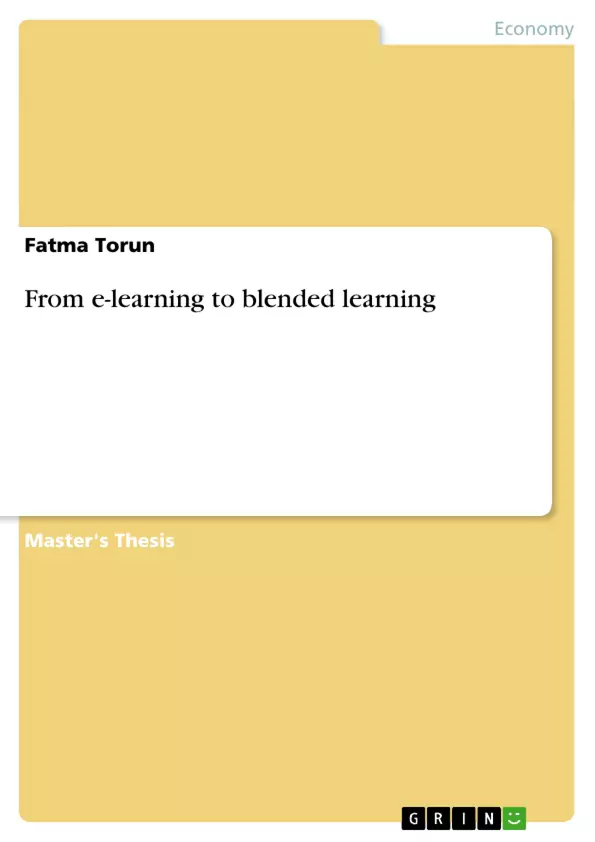In today’s economy, companies are increasingly facing new challenges. High competition in a global market, shrinking corporate resources, rapid shifts in technology, and the recruitment and retention of talented and skilled people are just few of these challenges.
The economy demands that people’s knowledge and skill levels be constantly updated. A growing number of companies are developing a new learning culture. In the past companies have viewed training as a necessary expense rather than an investment. Emphasis was placed cutting on the expense of training by making it more efficient. Now, in response of these challenges, companies are beginning to view training as an investment. The knowledge and skills of the organisation’s employees are now being held on equal basis with the company’s monetary asset. Learning faster than other companies represents one of the most important competitive advantages.1
Here the Internet technology represents an unprecedented opportunity for training departments to add value to the organization. E-learning combines education, information, communication, training and knowledge management.2 It represents an all embracing and cost effective way of training staff. It can deliver on a global basis, while tailoring content to suit the needs of the individuals. It also allows an organization to regularly assess skills gaps. Its benefits have already been realised by a number of the world’s leading companies who prepare their workforce with elearning. Some case studies will be described in this report.
Inhaltsverzeichnis (Table of Contents)
- I. Introduction – “From E-Learning to Blended Learning”
- II. Theoretical Background
- 2.1 Learning theories of E-Learning
- 2.2 E-Learning
- 2.2.1 Benefits and Limits of E-Learning
- 2.2.2 E-Learning Organizations
- 2.2.3 Blended Learning
- III. Best Practice: Case Studies of E-Learning and Blended Learning
- 3.1 Case Study I: Management Training at IBM
- 3.2 Case Study II: BAE Systems – Virtual University
- 3.3 Case Study III: U.S. Military – Transforming military training
- 3.4 Case Study IV: Harvard Business School - Blended Learning
- IV. Pilot Project “E-Learning at XXX Spain”
- 4.1 Current situation of Training at XXX Spain
- 4.1.1 The Survey
- 4.1.2 General findings
- 4.2 Implementation of E-Learning at XXX
- 4.3 Return on Investment of E-Learning
- 4.3.1 The Value of E-Learning Training
- 4.3.2 The ROI of E-Learning
- 4.3.3 Example of E-Learning ROI at XXX Spain
- V. Implementation of Blended Learning at XXX Spain
- 5.1 Options of Blended Learning
- 5.2 Implementation of Blended Learning – Pilot Course “English”
Zielsetzung und Themenschwerpunkte (Objectives and Key Themes)
This report aims to provide a comprehensive overview of e-learning and blended learning, emphasizing their practical application within the context of XXX SA. The report outlines a strategic approach to implement these learning methods successfully, ensuring alignment with business goals and demonstrating the value of these training tools.
- The changing landscape of corporate training and the need for a learning culture
- The theoretical foundations of e-learning and blended learning, including learning theories and their application
- Best practices and case studies from leading organizations implementing e-learning and blended learning
- A practical pilot project for e-learning implementation at XXX Spain, including its impact on training and return on investment
- The strategic implementation of blended learning at XXX Spain, incorporating practical examples and a pilot course.
Zusammenfassung der Kapitel (Chapter Summaries)
The report begins by examining the evolving nature of corporate training in today's competitive business environment. It emphasizes the importance of viewing training as an investment rather than an expense, and how companies must adapt to meet the needs of a dynamic global market. The introduction emphasizes the significance of e-learning and blended learning as tools for achieving this goal.
Chapter II delves into the theoretical foundations of e-learning and blended learning, exploring different learning theories and their relevance to these methods. It examines the definition and benefits of e-learning, discusses the importance of e-learning organizations, and introduces blended learning as a new approach combining traditional and online methods.
Chapter III presents case studies from leading organizations that have successfully implemented e-learning and blended learning. It examines various aspects of these programs, including their impact on training, employee engagement, and overall business performance.
Chapter IV focuses on a pilot project for e-learning implementation at XXX Spain. This chapter analyzes the current situation of training within the organization, discusses the implementation process, and explores the return on investment associated with e-learning.
Chapter V details the implementation of blended learning at XXX Spain. It explores different options for blending learning methods and presents a practical pilot course for “English.”
Schlüsselwörter (Keywords)
Key topics covered in this report include e-learning, blended learning, corporate training, learning theories, case studies, return on investment (ROI), and strategic implementation.
- Citation du texte
- Fatma Torun (Auteur), 2003, From e-learning to blended learning, Munich, GRIN Verlag, https://www.grin.com/document/32962



